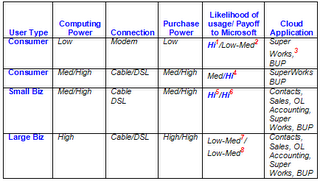If this anecdotal rationale is on target, then the users most likely to benefit from using Live services are small business users and home users with high bandwidth. Those least likely to benefit are home users with dial up because of their limited incomes and slow download times and big businesses because of their legacy systems and aversion to ad-supported software solutions.
Also, here are some benefits of using Live Services.
- No LAN or Server required - means all the costs associated with care and feeding of a server/LAN are unncessary.
- Low maintenance involved in storing and backing up information - it can be redundantly stored on line, free from fire and disaster (and the need to bring your dvd with you in the car).
- Information shared among many users on high speed Internet vs. bottlenecked LAN; great for collaboration and/or specialization of labor (A/R, A/P, Billing, Payroll)
- No program installation and upgrading woes/fees - it's all located off site and upgraded daily/periodically.
- Rapid updating/processing of user numerical information - huge files -- accounting, contact, project-- can be updated at the server farm where all the processing power resides.
- Less expensive cpu/HDD/memory requirements (unless Aero used). Cheaper workstations can be used because much of the processing and program is done online.
- No user BUP uninterruptable power supply needed.
- Lower user media costs -- CD/DVD.
- Marketing statisics gathered at the server farm level for pinpoint sales analysis and subsequent promotional contact.
- Free Software - Ad based model makes software free to users.
- Less expensive CPU/HDD/memory requirements (unless Aero used). Cheaper computers can be for other family members because much of the processing and program is done online.
- Lower user media costs -- CD/DVD -- none required for home backups.
- Applications rolled out with great ease -- e.g. - users simply log on to their video editing program.
- Marketing statisics gathered at the server farm level for pinpoint sales analysis and subsequent promotional contact.
In the home user/high bandwidth arena, the opportunities are less clear. Microsoft should leverage it's current MS Office with other online products to make the buying proposition "irresistable" when compared to Google, et. al. At this point, it is behind the 8 ball.
This author believes there are two (2) previously untapped opportunities to sweeten the online pot by:
- Attracting low income home users by offering very cheap pc's and subsidized cable/DSL. This opens up the ad-based market to a huge marketplace. A lesson I learned in by door-to-door Fuller Brush days was that "the lower income people (unfortunately for them) would buy the most product." So, with enough bandwidth, the ad market will be there.
- Offering Microsoft "points" to search advertisers, buyers, shoppers and searchers in a synergized award/reward system. Points to be redeemed towards goods, services and advertising.

(Click to Enlarge)
Explanations:
1,2 High likelihood of usage from low income user but, low payoff to Microsoft and its advertisers because, although exposed to ads, the chances of purchase, because of low income and slow download speeds, are less. So, it might be useful to appeal to modem users with certain types of ads.
3 Super Works is a hybrid product with a combination of Works and Word attributes, otherwise…why go online (and thus, why view the ads?) Think about it, Ray Ozzie.
4 High payoff to Microsoft from hi bandwidth consumer because they can backup their data and use online tools that are better than MS Works.
5,6 Matrix concludes that small biz is the best market because they have fewer tools and could benefit the most from a variety of Live Services. Training would be a great tool to offer here, as a Live Service! Small biz, because of their small budgets would be willing to view ads and/or some hybrid subscription service based upon their budgets.
7,8 Matrix concludes Large Biz not a viable business model for Live Services because of legacy products and immaturity of Microsoft large biz vertical offerings. Additionally, advertising model wouldn’t work here but, subscription would.
Mini-Microsoft: Rebuilding Microsoft in Wired Magazine

0 Comments:
Post a Comment
<< Home